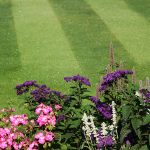How to Get A Healthy Lawn
How to Achieve a Healthy Lawn: Expert Tips from Natorp’s Nursery
Wondering how to get a lush, healthy lawn? Keeping your lawn vibrant and green can be challenging, but you can achieve beautiful results with a few expert tips. Here’s how: 
1. Mow Higher for Healthier Grass
Raising your mower height is essential for a healthier lawn. Most cool-season grasses do best when kept between 2 ½ and 3 ½ inches. Longer grass provides more shade, helps retain soil moisture, and promotes deep, thick roots. Taller grass also requires less frequent mowing, making lawn maintenance easier.
- Tip: Avoid cutting more than one-third of the grass blades at each mow, and let the clippings fall back onto the turf. These clippings decompose quickly, returning essential nitrogen to the soil.
2. Keep Your Mower Blade Sharp
A sharp mower blade is key to a clean cut. Sharpen the blade every 12-15 hours of mowing or at least 2-3 times per season. A clean cut reduces the risk of disease and keeps your lawn looking vibrant rather than brown or yellowed from torn blades.
3. Vary Your Mowing Direction
To keep grass blades upright and healthy, alternate your mowing pattern each time. Try mowing north-south for one week, then switch to east-west, and occasionally mow diagonally. This approach keeps grass growing upright and minimizes matting.
4. Core Aerate for Better Air, Water, and a Healthy Lawn
Core aeration (removing small plugs of soil) helps break up compacted soil, allowing better airflow and water absorption. It’s particularly beneficial for high-traffic areas. After aerating, consider topdressing with compost to add organic matter to the soil. Depending on soil type and traffic, this is best done in spring or fall.
5. Water Deeply and Wisely
Lawns generally need about an inch of water every 10 days. If rainfall is insufficient, water should be used deeply but infrequently to encourage root growth. Aim for early morning watering (5-9 AM) for best results; late afternoon is acceptable, but avoid midday and nighttime watering to reduce the risk of disease.
6. Feed According to Your Grass Type
Two fall feedings are most important for cool-season grasses, with additional spring feeding as needed based on grass type, soil, and weather conditions. Testing your soil’s nutrient and pH levels helps you understand what your lawn needs.
7. Choose the Right Grass for Your Lawn
Selecting a grass type that suits your climate and soil conditions is essential. There’s no single “best” grass, but some varieties perform better than others. Consult with our lawn care professionals to determine the best grass blend for your area.
The Key to a Thick, Healthy Lawn
A dense, healthy lawn naturally resists weeds and disease. While no lawn is entirely weed or disease-free, following these best practices can greatly reduce issues and create a beautiful landscape.